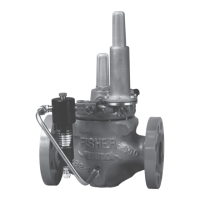17E68
NITRILE (NBR)
17E97
(1)
NITRILE (NBR)
17E88
FLUOROCARBON (FKM)
Gas Temperature
(for lower temperatures
contact your local Sales Ofce)
-20 to 150°F / -29 to 66°C 0 to 150°F / -18 to 66°C 0 to 260°F / -18 to 127°C
(2)
General Applications Best for cold temperatures.
Best for high pressure conditions, i.e.
transmission service or high pressure
industrial service. It is also the best for
abrasive or erosive service applications.
Best for natural gas having aromatic
hydrocarbons. It is also the best for high
temperature applications.
Heavy Particle Erosion Fair Excellent Good
Natural Gas With:
Up to 3% aromatic
hydrocarbon content
(3)
Good Excellent
Excellent
3 to 15% aromatic
hydrocarbon content
(3)
Poor Good
15 to 50% aromatic
hydrocarbon content
(3)
Not recommended Poor
Up to 3% H
2
S (hydrogen
sulde or sour gas)
Good Good Good
Up to 3% ketone Fair Fair
Fair
Up to 10% alcohol Good Good
Up to 3% synthetic lube Fair Fair Good
1. The NPS 6 / DN 150, 17E97 diaphragm will perform in gas temperatures as low as -20°F / -29°C.
2. For differential pressures above 400 psig / 27.6 bar diaphragm temperature is limited to 150°F / 66°C.
3. The aromatic hydrocarbon content is based on percent volume.
Table 8. Diaphragm Material Selection Information
MONITORING PILOT MINIMUM PRESSURE OVER NORMAL DISTRIBUTION
PRESSURE AT WHICH MONITOR PILOT CAN BE SET
WITH A RESTRICTOR SETTING OF 2
Construction Outlet (Control) Pressure Range Spring Part Number
Type 161AY or
161AYM
6 to 15 in. w.c.
0.5 to 1.2 psig
1.2 to 2.5 psig
2.5 to 4.5 psig
4.5 to 7 psig
15 to 37 mbar
34 to 83 mbar
83 mbar to 0.17 bar
0.17 to 0.31 bar
0.31 to 0.48 bar
1B653927022
1B537027052
1B537127022
1B537227022
1B537327052
1 in. w.c.
1 in. w.c.
0.5 psig
0.5 psig
0.5 psig
2 mbar
(1)
2 mbar
(1)
34 mbar
(1)
34 mbar
(1)
34 mbar
(1)
Type 161EBM
5 to 15 psig
10 to 40 psig
30 to 75 psig
70 to 140 psig
130 to 200 psig
200 to 350 psig
0.34 to 1.0 bar
0.69 to 2.8 bar
2.1 to 5.2 bar
4.8 to 9.7 bar
9.0 to 13.8 bar
13.8 to 24.1 bar
17B1260X012
17B1262X012
17B1259X012
17B1261X012
17B1263X012
17B1264X012
0.5 psig
0.5 psig
0.6 psig
1.3 psig
1.5 psig
3 psig
34 mbar
(1)
34 mbar
(1)
41 mbar
(1)
90 mbar
(1)
0.10 bar
(1)
0.21 bar
(1)
1. Monitor pilot minimum setpoint was determined with a pressure drop ranging from 50 to 150 psig / 3.5 to 10.3 bar. Approximately double the minimum monitor pilot setpoint.
Table 9. Type EZR Working Monitor Performance
is not necessary. The “0” setting has the smallest
(minimum) ow passage; at no point of rotation will the
Type 112 restrictor be completely shut off. After initial
adjustment, the restrictor does not need to be adjusted
for maintenance or startup.
Low Flow Application Considerations
For stable, low ow operation, other considerations
besides pilot settings should also be addressed.
Installation of an oversized regulator may make low ow
operation difcult. When possible, a smaller-sized
Type EZR should be installed. Reduced capacity trim
reduces relief valve requirements by decreasing the
maximum possible ow through the regulator but does
not improve low ow performance. During design of a
regulator installation, the downstream piping volume
should be maximized. Control lines should not be located
in or near piping sections that may experience turbulent
ow, such as elbows or swages. Larger diameter control
lines are also recommended in low ow conditions. The
larger control lines are less restrictive and will reduce pilot
exhaust bleed backpressure to the pilot that may cause
instability. Separate sense and exhaust lines may also
help at low ow conditions. This feature is provided on the
PRX Series, Types 161EBM and 161AYM pilots. Control
line taps should be located in straight pipe; several
pipeline diameters (8 to 10 of largest piping on outlet)
downstream of the regulator. These guidelines have been
used to improve station stability at low ow.
13
Type EZR

